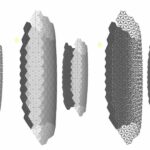A team of researchers from the National Institute for Materials Science, the University of Tokyo and the Tokyo University of Science has for the first time developed a technology that enables precise doping of organic semiconductors in aqueous solutions. The latest technology, which does not require special equipment to obtain a nitrogen environment in a vacuum, is expected to bring about a breakthrough in the field of semiconductors and find use in healthcare and biosensing. The paper was published in the latest issue of the journal Nature.
In the latest study, scientists developed a new chemical doping technique. Redox reactions using benzoquinone and hydroquinone are carried out in aqueous solutions under ambient conditions at rates that can be controlled by the acidity of the solution (a mechanism that also exists for the electron transport chain in photosynthesis).

The team achieved chemical doping of organic semiconductor films by immersing them in an aqueous solution containing benzoquinone, hydroquinone, and hydrophobic ions. They accurately controlled the level of doping by changing the pH of the solution to produce semiconductors with a wide range of conductivity.
The researchers note that flexible and lightweight organic semiconductors are suitable for use as materials for inkjet printing and other low-cost printing processes. The latest chemical doping technology is expected to facilitate the industrial production of flexible organic film devices in the field of sensors, electronic circuits, displays solar cells, etc., “to make a difference”. The latest technology also validates the concept of thin-film pH sensors for future applications in healthcare and biosensing.
In addition, the team was able to accurately and consistently control the doping levels by changing the pH of the solution, resulting in the production of semiconductors with a wide range of electrical conductivity approximately five orders of magnitude of difference between the minimum and maximum conductivity.
Flexible, lightweight organic semiconductors can be used as materials suitable for inkjet printing and other low-cost printing processes. The chemical doping technique may be used to promote the industrial production of flexible organic film devices, including sensors, electronic circuits, displays, and solar cells.
The proof of concept for a thin-film pH sensor was also demonstrated by employing this novel technique, which suggests possibilities for health care and biosensing applications.












Leave a comment